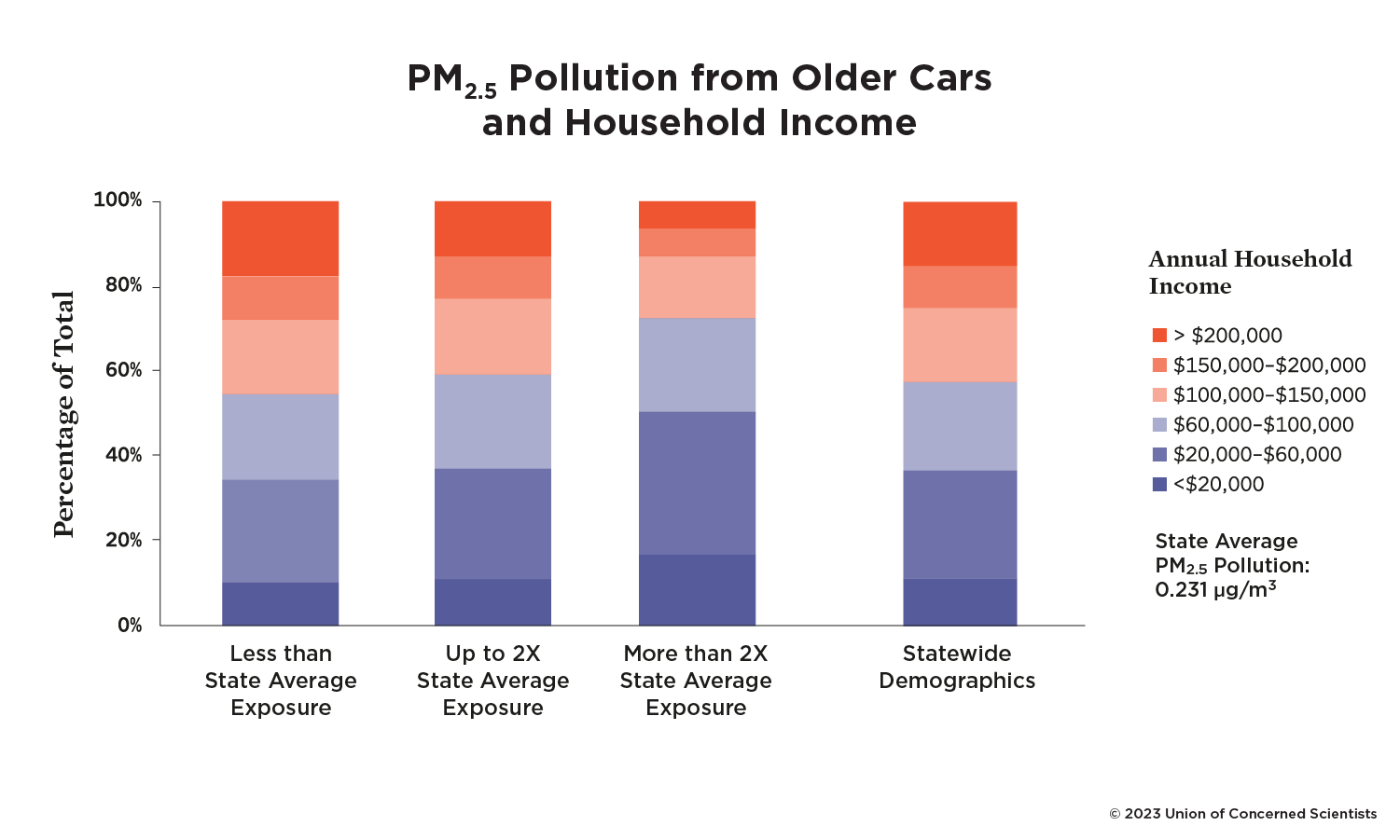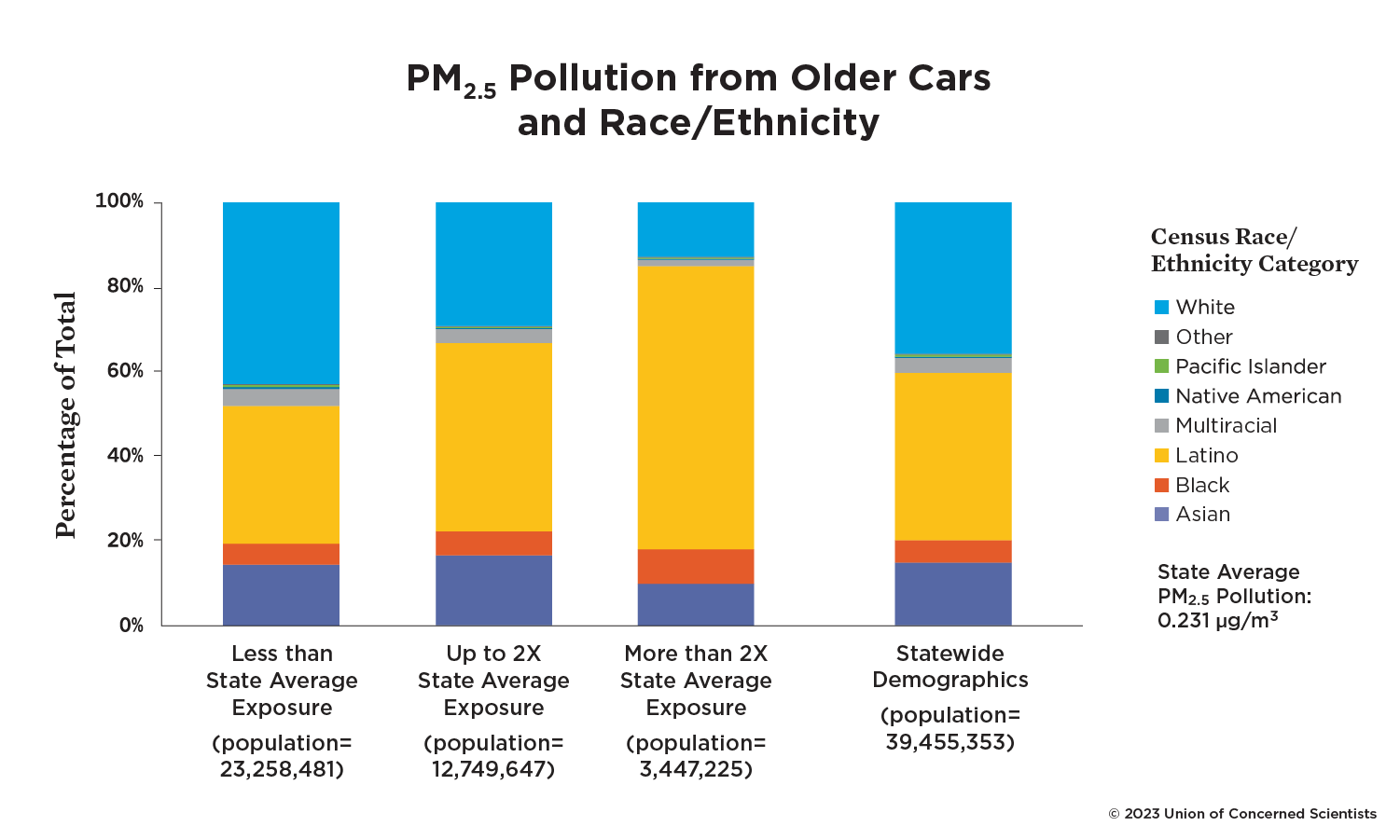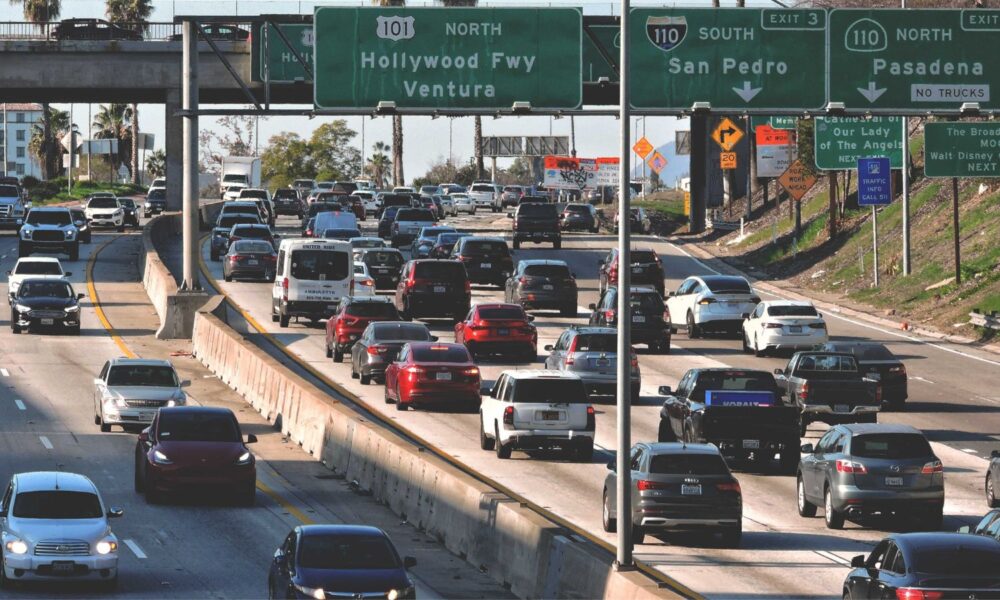California has a long history of poor air quality and much of the pollution fouling the air is from cars and trucks.
As early as 1966, the state began to take regulatory action to reduce pollution from passenger cars and trucks. As a result of continuing progress on regulations, the air-polluting emissions of new passenger vehicles currently for sale are thankfully much lower than those of older vehicles. However, the emissions from older vehicles still produce significant air pollution.
To learn more about who in the state is exposed to this harmful exhaust, UCS partnered with The Greenlining Institute to analyze the location of these vehicles and their emissions. In this new report, we found that the exposure to pollution from older gasoline and diesel vehicles is inequitable. The harms fall disproportionately on Latino and Black Californians, lower-income households, and communities the state designates as disadvantaged.
California already has programs that help low-income residents buy or lease cleaner vehicles, but the state can save lives by better targeting these programs to disadvantaged communities with high concentrations of older cars.
Older vehicles pollute more and are a fraction of those on the road
Beginning with model year 2004, California has implemented Low-Emission Vehicle (LEVII) tailpipe pollution standards for passenger vehicles. Older vehicles (pre-2004) make up 19% of the state’s passenger vehicles and only 12% of miles driven, yet they emit almost 3 times as much smog-forming, nitrogen-oxide pollution as all 2004 and later vehicles combined.
These older vehicles are responsible for 73% of all nitrogen oxide exhaust from passenger vehicles and 64% of reactive organic gases. These pollutants react in the atmosphere to form harmful particulate matter pollution known as PM2.5.
Exposure to harmful air pollution from older vehicles is inequitably distributed
Using an air-quality model and data from the California Air Resources Board about the location of vehicles and their emissions, we estimated the formation and transport of PM2.5 pollution from the use of older passenger vehicles (defined as model year 1976 through 2003) and newer ones (model year 2004 through 2021). Combining the PM2.5 pollutant concentration with US Census data, we estimated the exposure of Californians to harmful air pollution from older cars.
Our analysis shows that PM2.5 exposure from the use of pre-2004 vehicles is inequitably distributed across racial and demographic groups in California. The communities with the highest pollution burden due to PM2.5 from older vehicles–more than twice the state average–have a higher percentage of low- and moderate-income households than areas unburdened by air pollution from these vehicles. In the parts of the state with the highest exposure to PM2.5 pollution from older vehicles, more than half of households have an income of less than $60,000 a year. In areas with the least exposure, only 35% of households have an income of less than $60,000 a year.

We also found racial and ethnic disparities in the exposure to air pollution from older vehicles. White Californians are on average exposed to 20% lower concentrations of PM2.5 than the state average. Latino Californians are exposed to 19% higher concentrations, and Black Californians are exposed to 12% higher concentrations.
Communities with the highest exposure to PM2.5 from older vehicles–greater than twice the state average–are home to much higher proportions of Latino and Black people than the state as a whole. In these areas with the highest exposure, 67% of the population are Latino and 8% are Black; the state as a whole is 40% Latino and 5% Black. In contrast, those same areas of highest exposure are only 13% White; the state is 36% White.

Rural areas have a higher proportion of older vehicles
While Southern California’s urban areas have the most older vehicles (and highest exposure to the resulting pollution), rural areas have higher proportions of older vehicles. For example, in rural Modoc, Trinity, and Sierra counties, more than 40% of vehicles are model year 2003 or older. In contrast, Orange, San Francisco, and Riverside counties, all of which are much more urban, have the lowest percentages of older cars.
Pollution from older vehicles leads to premature deaths
To estimate the health impacts of PM2.5 pollution exposure resulting from older vehicles, we examined two scenarios considering the emissions from engine starts, evaporative emissions, and driving. These scenarios provided a range for the estimated premature deaths in California.
One scenario only considered cold-start emissions and assumed those happen where the vehicle is registered. The second scenario assumed that all tailpipe emissions happen where the vehicle is registered. Air quality modeling allows us to estimate the exposure to the PM2.5 pollution that results from these emissions and the resultant premature deaths. We estimated that older-vehicle emissions led to between 97 and 421 premature deaths per year.
These four policies can reduce inequitable exposure to pollution
Based on the impacts of older cars on local air quality and public health, it is imperative that California’s incentive programs for retiring and replacing vehicles prioritize getting the oldest cars off the state’s roads.
Policymakers also should ensure that programs benefit disadvantaged and low-income communities. Moreover, when developing new policies and programs, California should involve–and in meaningful ways–the communities most impacted by older-vehicle emissions. This will help the state identify approaches to reducing the inequitable distribution of this pollution from older passenger vehicles.
UCS and The Greenlining Institute recommend the following changes in state policies and programs:
- Prioritize incentives toward priority populations owning old cars. State agencies should integrate programmatic changes to existing incentive programs, such as Clean Cars 4 All and the Clean Vehicle Assistance Program, to prioritize investments in low-income and disadvantaged communities with high concentrations of older cars.
- Target outreach and education. State and local agencies should target their limited outreach and education funds to households in areas with high concentrations of old cars and limited uptake of zero-emission vehicles.
- Provide transportation solutions that go beyond private passenger vehicles. Even as California attempts to reduce vehicle miles traveled, it continues to invest in vehicle incentive programs that prioritize car ownership. Agencies should consider further funds for programs that promote alternative modes of transportation, such as public transportation walking, car sharing, and e-biking.
- Evaluate and adjust incentive programs based on changing conditions in the electric vehicle market. Despite declining prices for electric vehicles, the pandemic’s impact on the supply of electric vehicles has created barriers to the purchase of both new and used electric vehicles. California should continue to evaluate and adapt its incentive programs to best assist people based on their needs. While a complete switch to zero-emissions technology will happen in the longer term, the current limited supply of electric vehicles can make their purchases more difficult in the near term. Thus, the state should encourage drivers to switch to cleaner and cheaper-to-fuel vehicles, including both zero- and low-emissions vehicles.
A cleaner, safer transportation future for all Californians is possible. To realize it, the state must commit to retiring the dirtiest vehicles on the road. With sustained investment and targeted policies, California can protect its vulnerable communities from harmful air pollution, saving money and lives.

